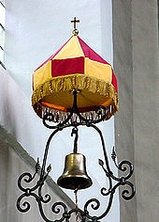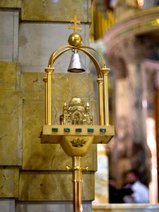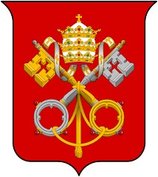About Basilicas
The term basilica comes from a Greek word meaning "regal", or above the rest. The Catholic Church has used basilica in this sense, with the Pope granting the title of Basilica to a church that has unusual historical significance, or is especially sacred because of its architectural beauty, liturgical renown, or significance as a place of worship. There are over 1,850 basilicas worldwide, with the most, 580, being in Italy. There are currently 93 basilicas in the United States, all of which are Minor Basilicas.
Minor Basilica? Does that mean there are Major Basilicas?
Yes! There are 4 Major Basilicas, also called Papal Basilicas, all of which are located in Rome:
1. The Basilica of St. John Lateran
2. St. Peter's Basilica
3. Basilica of St. Paul Outside the Walls
4. Basilica of Saint Mary Major
These 4 churches are the holiest Roman Catholic churches. They each possess a papal throne, and an altar over which only the pope (or someone he directly delegates) may preside. Each of the Major Basilicas also contains a holy door that is sealed except during Holy Years of Jubilee. It is popular during Jubilee years for Catholics to pilgrimage to Rome to pass through at least one of these doors.
You said the pope grants the title of Minor Basilica. How does that process work?
The process begins when a church petitions its local Diocese for permission to apply to become a Basilica. Their petition will outline the reasons they believe their church is worthy of distinction as a basilica. The request is denied or approved by the bishop of the Diocese.
If approved locally, the church can begin its formal application with the Vatican. The Vatican's application is provided by The Congregation for Divine Worship and Discipline of the Sacraments (CDWDS). It is the office of the Holy See which the Pope entrusts to review applicants for Basilica status. The office is currently headed by Archbishop Arthur Roche. The application is entirely in Latin, and consists of a questionnaire with 119 segments, exploring not only the physical architecture of the church and the appointments of its buildings, but also its art, liturgical life, religious devotions, participation of the laity, charitable works, and historical relevance.
After completing the application, the church must then seek a " favorable judgment" on their completed application from the national Episcopal Conference. In the U.S., this conference is the United States Conference of Catholic Bishops (USCCB).
If a favorable judgment is received, the application, along with the approvals from the local Diocesan and the USCCB, are sent to the CDWDS in Rome. The CDWDS will review the application on behalf of the Pope and notify the church of their decision. There is no timeline for the CDWDS to make a decision. Some approvals have taken a few months, while others have taken years.
Are there certain privileges that come with becoming a basilica?
Yes! There are certain privileges bestowed upon on all churches that have been designated as basilicas:
Minor Basilica? Does that mean there are Major Basilicas?
Yes! There are 4 Major Basilicas, also called Papal Basilicas, all of which are located in Rome:
1. The Basilica of St. John Lateran
2. St. Peter's Basilica
3. Basilica of St. Paul Outside the Walls
4. Basilica of Saint Mary Major
These 4 churches are the holiest Roman Catholic churches. They each possess a papal throne, and an altar over which only the pope (or someone he directly delegates) may preside. Each of the Major Basilicas also contains a holy door that is sealed except during Holy Years of Jubilee. It is popular during Jubilee years for Catholics to pilgrimage to Rome to pass through at least one of these doors.
You said the pope grants the title of Minor Basilica. How does that process work?
The process begins when a church petitions its local Diocese for permission to apply to become a Basilica. Their petition will outline the reasons they believe their church is worthy of distinction as a basilica. The request is denied or approved by the bishop of the Diocese.
If approved locally, the church can begin its formal application with the Vatican. The Vatican's application is provided by The Congregation for Divine Worship and Discipline of the Sacraments (CDWDS). It is the office of the Holy See which the Pope entrusts to review applicants for Basilica status. The office is currently headed by Archbishop Arthur Roche. The application is entirely in Latin, and consists of a questionnaire with 119 segments, exploring not only the physical architecture of the church and the appointments of its buildings, but also its art, liturgical life, religious devotions, participation of the laity, charitable works, and historical relevance.
After completing the application, the church must then seek a " favorable judgment" on their completed application from the national Episcopal Conference. In the U.S., this conference is the United States Conference of Catholic Bishops (USCCB).
If a favorable judgment is received, the application, along with the approvals from the local Diocesan and the USCCB, are sent to the CDWDS in Rome. The CDWDS will review the application on behalf of the Pope and notify the church of their decision. There is no timeline for the CDWDS to make a decision. Some approvals have taken a few months, while others have taken years.
Are there certain privileges that come with becoming a basilica?
Yes! There are certain privileges bestowed upon on all churches that have been designated as basilicas:

1. The right to display a Umbraculum. During the Middle Ages, a Umbraculum would be carried above the Holy Father during processions. Designed with stripes of yellow and red (traditional papal colors), the silk canopy is a symbol of the Pope's authority and is displayed prominently on the right side of the main altar at every basilica.

2. The right to display a Tintinnabulum. During the Middle Ages and Renaissance, the Tintinnabulum was used to alert the people of Rome of the approach of the Holy Father during processions. The Tintinnabulum consists of a small gold bell within a hard carved wooden frame accented with gold leaf surmounted by the Papal Tiara (the crown traditionally wore by the Pope) and the Papal Keys (see Matthew 16:13-16:19). It is typically mounted on a pole and displayed in the church sanctuary.

3. The right to display the Papal Symbol of Crossed Keys on banners, furnishings, and on the seal of the Basilica.

4. A special privilege is provided to the Rector of a Basilica in that he may wear a black 'mozetta' or cap over his surplice with red piping, buttons, and buttonholes in the exercise of his office.
Photos are courtesy of Bellevision Media Network.
Photos are courtesy of Bellevision Media Network.
I get confused between cathedrals and basilicas. What's the difference?
A cathedral is the home church for the bishop or archbishop of a Catholic diocese. It takes its name from the bishop's chair, called a cathedra in Latin.
A basilica is simply an important church building designated by the Pope because it carries special significance. A basilica may or may not be also the cathedral of the diocese. For example, the University of Notre Dame has the Basilica of the Sacred Heart on its campus, but its not where the primary cathedral of the Diocese of Fort Wayne-South Bend is located.
In terms of precedence, the papal or major basilicas outrank all other churches. The cathedral of a bishop outranks all other churches in the same diocese, even if they have a minor basilica.
A cathedral is the home church for the bishop or archbishop of a Catholic diocese. It takes its name from the bishop's chair, called a cathedra in Latin.
A basilica is simply an important church building designated by the Pope because it carries special significance. A basilica may or may not be also the cathedral of the diocese. For example, the University of Notre Dame has the Basilica of the Sacred Heart on its campus, but its not where the primary cathedral of the Diocese of Fort Wayne-South Bend is located.
In terms of precedence, the papal or major basilicas outrank all other churches. The cathedral of a bishop outranks all other churches in the same diocese, even if they have a minor basilica.
